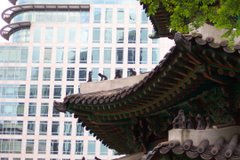Recent arguments on the Anti-Americanism in Korea were more based on the political change in Korea. Especially, when center-left government came to power, many conservatives argued that the US-ROK Alliance was in danger by the leftist regime in Korea. I would like to introduce their articles and criticize them.
• Victor D. Cha, “South Korea: Anchored or Adrift?” in Richard Ellings & AaronFriedberg (eds.), Strategic Asia 2003-04: Fragility and Crisis, pp. 109-129.
• Seung-Hwan Kim, “Anti-Americanism in Korea,” The Washington Quarterly vol.26, no. 1 (Winter 2002-03), pp. 109-122.
• Hahm Chaibong, “The Two South Koreas: A House Divided,” The WashingtonQuarterly Vol. 28, No.3 (Summer 2005), pp. 57-72.
Victor Cha argued that the alliance is deteriorated and South Korea is “seeking neutrality from the US and pursuing China as a new patron while unconditionally engaging North Korea.” He also claimed that “South Korea drifted away from the US by the issue of unification and such unification jitters have adversely impacted Seoul’s ability to form a common front toward North Korea with the US.” Seung-Hwan Kim asserted that “Anti-American sentiments have now spread into almost all strata of Korean society.” Hahm Chaibong even insisted that radical leftists who oppose capitalism and US-ROK alliance came to power with President Kim Dae-Jung and Roh Moo-hyun.
It is true that there was significant ideational change after the Sunshine policy and the summit between President Kim Dae-Jung and Kim Jung-Il in 2000. And following activities such as reunion of separated family, cultural exchanges, Kumgang mountain tour, economic cooperation brought substantial ideational change that both Koreas have many things in common and they should finish the 50 years of confrontation and achieve peaceful reunification. South Korean people also found that North Korea had some intention to reform their economy and end its isolation by the support of South Korea.
However, ideational change after the Sunshine policy did not lead to the Anti-Americanism or alliance adjustment. The US and South Korean government were very much in cooperation until the end of Clinton administration. President Clinton even said to Kim Dae-Jung that they would have resolved North Korean nuclear crisis, if he had one more year in the office. It was Bush administration and Neoconservatives who changed course of action and brought the discrepancies. In the summit between President Kim Dae-Jung and President Bush in April 2001, President Bush expressed his strong skepticism on the Sunshine policy, and he provoked Korean people with the rhetoric such as ‘the axis of evil’ and ‘the preemptive strike.’ Most of foreign people would be surprised that Koreans are not so much sensitive about North Korean nuclear plan and still maintain the sunshine policy, but, again, the worst scenario of all for the Korean people is not a nuclear North Korea (even though it is a very serous problem) but another war between two Koreas. And Bush administration’s approach toward North Korea was posing serious threat and enhancing the possibility of war in Korean peninsular. And after the death of two middle school girls by the US vehicle, and the acquittal of the US soldiers, the so called ‘Anti-Americanism’ began to rise. However it was not an ‘Anti-American sentiment’ but more ‘Anti-Bushism’ and the request for the revision of the SOFA which was revised in 60s and still has many unequal provisions.
So called ‘Anti-Americanism’ is exaggerated by the ‘alliance jitters’. It never leads to the serious consideration to adjust US-ROK Alliance. Ham Chaibong even depicted Kim Dae-Jung and Roh Moo-hyun as dangerous leftist but it is far from the reality. Kim adopted very conservative economic policy as the treatment of the financial Crisis and Roh became more realistic and even conservative after he became a president. He dispatched Korean soldiers (the third largest dispatch after the US and the UK) to Iraq in spite of strong domestic opposition and also pushed US-Korean Free Trade Agreement which is very controversial. Therefore progressive group even criticized that he betrayed his own constituency to strengthen the US-ROK alliance. And both Kim and Roh argued that the US forces should stay in Korean peninsular as a stabilizer even after the reunification. Also, there was strong counterattack from conservative groups after the second nuclear crisis in 2003. There was division between the ‘progressive and pro-unification group’ and the ‘conservative and anti-communist group’ and heated debate within society. It is more natural to go through such process if we consider the power shift and changes around the Korean peninsular. It was a swing of pendulum but the South Korean society soon found some equilibrium: continuation of the Sunshine policy and strong US-ROK alliance.
Wednesday, February 13, 2008
Subscribe to:
Post Comments (Atom)

1 comment:
yup!
right on!
well said!
I am totally in agreement with you.
Post a Comment